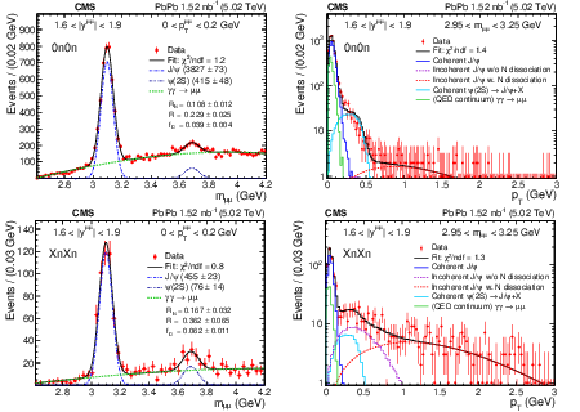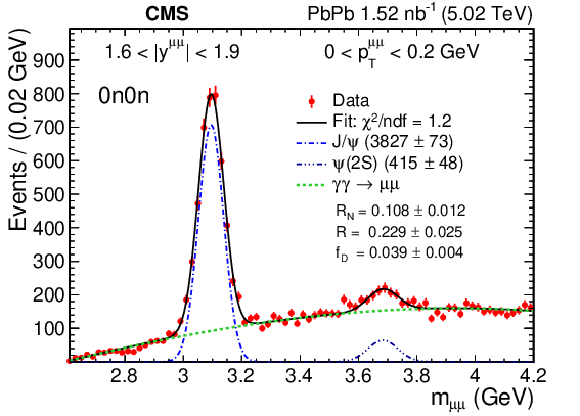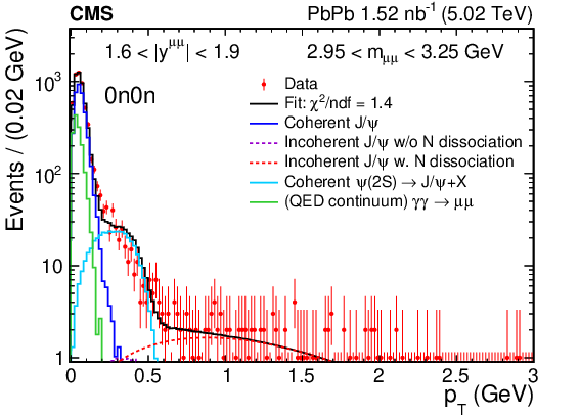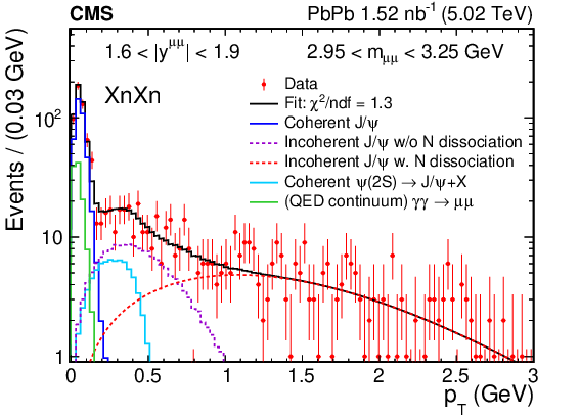

Compact Muon Solenoid
LHC, CERN
| CMS-HIN-22-002 ; CERN-EP-2023-031 | ||
| Probing small Bjorken-$ x $ nuclear gluonic structure via coherent J/$\psi $ photoproduction in ultraperipheral Pb-Pb collisions at $ \sqrt{\smash[b]{s_{_{\mathrm{NN}}}}} = $ 5.02 TeV | ||
| CMS Collaboration | ||
| 29 March 2023 | ||
| Phys. Rev. Lett. 131 (2023) 262301 | ||
| Abstract: Quasireal photons exchanged in relativistic heavy ion interactions are powerful probes of the gluonic structure of nuclei. The coherent J/$ \psi $ photoproduction cross section in ultraperipheral lead-lead collisions is measured as a function of photon-nucleus center-of-mass energies per nucleon ($ W^{\mathrm{Pb}}_{\gamma\mathrm{N}} $) over a wide range of 40 $ < W^{\mathrm{Pb}}_{\gamma\mathrm{N}} < $ 400 GeV. Results are obtained using data at the nucleon-nucleon center-of-mass energy of 5.02 TeV collected by the CMS experiment at the CERN LHC, corresponding to an integrated luminosity of 1.52 nb$^{-1}$. The cross section is observed to rise rapidly at low $ W^{\mathrm{Pb}}_{\gamma\mathrm{N}} $, and plateau above $ W^{\mathrm{Pb}}_{\gamma\mathrm{N}} \approx $ 40 GeV, up to 400 GeV, entering a new regime of small Bjorken-$ x $ ($ {\approx}$ 6 $\times$ 10$^{-5} $) gluons being probed in a heavy nucleus. The observed energy dependence is not predicted by current quantum chromodynamic models. | ||
| Links: e-print arXiv:2303.16984 [hep-ex] (PDF) ; CDS record ; inSPIRE record ; HepData record ; CADI line (restricted) ; | ||
| Figures | |

png pdf |
Figure 1:
A pictorial representation of the J/$\psi$ photoproduction process in PbPb at leading-order QCD, showing the origin of the two-way ambiguity. The blue wavy and black helical lines represent emitted photons and gluons, respectively. |

png pdf |
Figure 2:
The differential coherent J/$\psi$ photoproduction cross section as a function of rapidity, in different neutron multiplicity classes (left): 0n0n, 0nXn and XnXn; (right): AnAn. The small vertical bars and shaded boxes represent the statistical and systematic uncertainties, respectively. The horizontal bars show the bin widths. Theoretical predictions from LTA weak/strong shadowing [34], color dipole models (CD_BGK,CD_BGW, and CD_IIM) [57], and STARLIGHT [47] are shown by the curves. The right plot also displays the results from the ALICE [13,15] and LHCb [17] experiments. |

png pdf |
Figure 2-a:
The differential coherent J/$\psi$ photoproduction cross section as a function of rapidity, in 0n0n, 0nXn and XnXn neutron multiplicity classes. The small vertical bars and shaded boxes represent the statistical and systematic uncertainties, respectively. The horizontal bars show the bin widths. Theoretical predictions from LTA weak/strong shadowing [34], color dipole models (CD_BGK,CD_BGW, and CD_IIM) [57], and STARLIGHT [47] are shown by the curves. |

png pdf |
Figure 2-b:
The differential coherent J/$\psi$ photoproduction cross section as a function of rapidity, with neutron multiplicity selection (AnAn). The small vertical bars and shaded boxes represent the statistical and systematic uncertainties, respectively. The horizontal bars show the bin widths. Theoretical predictions from LTA weak/strong shadowing [34], color dipole models (CD_BGK,CD_BGW, and CD_IIM) [57], and STARLIGHT [47] are shown by the curves. The plot also displays the results from the ALICE [13,15] and LHCb [17] experiments. |

png pdf |
Figure 3:
The total coherent J/$\psi$ photoproduction cross section as a function of $ W^{\mathrm{Pb}}_{\gamma\mathrm{N}} $ from the CMS measurement in PbPb UPCs at $ \sqrt{\smash[b]{s_{_{\mathrm{NN}}}}} = $ 5.02 TeV. Approximated results (implied by the asterisk) from the ALICE [13,15] and LHCb [17] experiments are displayed for specific rapidity regions, where the two-way ambiguity effect is expected to be negligible. The $ W^{\mathrm{Pb}}_{\gamma\mathrm{N}} $ values used correspond to the center of each experiment's rapidity range. The vertical bars and the shaded and open boxes represent the statistical, experimental, and theoretical (photon flux) uncertainties, respectively. The predictions from various theoretical calculations [33,59,60,34,58,57] are shown by the curves. |

png pdf |
Figure 4:
The nuclear gluon suppression factor $ R^{\mathrm{Pb}}_{\mathrm{g}} $ as a function of Bjorken $ x $ extracted from the CMS measurement of the coherent J/$\psi$ photoproduction in PbPb UPCs at $ \sqrt{\smash[b]{s_{_{\mathrm{NN}}}}}= $ 5.02 TeV. Approximated results (implied by the asterisk) from the ALICE [13,15] and LHCb [17] experiments are displayed for specific rapidity regions, where the two-way ambiguity effect is expected to be negligible. A measurement of J/$\psi$ photoproduction from the E691 experiment [64,65] is also given. The $ x $ values are evaluated at the centers of their corresponding rapidity ranges. The vertical bars and shaded and open boxes represent the statistical, experimental systematic, and theoretical systematic uncertainties, respectively. The latter is due to the uncertainties in the photon flux and the IA. Predictions from various theoretical calculations [60,34,58,57] are shown by the curves. |

png pdf |
Figure 5:
The invariant mass distribution (left) of $ \mu^{+}\mu^{-} $ pairs in the dimuon $ p_{\mathrm{T}} < $ 0.2 GeV range from the 0n0n (upper) and XnXn (lower) neutron classes. The results of the fit are shown by the various curves, and the corresponding values of the $ \chi^2 $/ number of degrees of freedom (ndf) and the fitted number of J/$\psi $ and $\psi$(2S) candidates are given. The values of the factors $ R_{N} $, $ R $, and $ f_{\mathrm{D}} $, defined below, are also shown. The transverse momentum distribution (right) of $ \mu^{+}\mu^{-} $ pairs with a dimuon invariant mass in the J/$\psi $ mass window of (2.95 $ < m_{\mu^{+}\mu^{-}} < $ 3.25 GeV) in the 0n0n (upper) and XnXn (lower) neutron classes. Again, the results of the fit are shown by the various curves. In both plots, the vertical bars on the data points represent statistical uncertainty. |

png pdf |
Figure 5-a:
The invariant mass distribution of $ \mu^{+}\mu^{-} $ pairs in the dimuon $ p_{\mathrm{T}} < $ 0.2 GeV range from the 0n0n neutron class. The results of the fit are shown by the various curves, and the corresponding values of the $ \chi^2 $/ number of degrees of freedom (ndf) and the fitted number of J/$\psi $ and $\psi$(2S) candidates are given. The values of the factors $ R_{N} $, $ R $, and $ f_{\mathrm{D}} $, defined below, are also shown. The vertical bars on the data points represent statistical uncertainty. |

png pdf |
Figure 5-b:
The transverse momentum distribution of $ \mu^{+}\mu^{-} $ pairs with a dimuon invariant mass in the J/$\psi $ mass window of (2.95 $ < m_{\mu^{+}\mu^{-}} < $ 3.25 GeV) in the 0n0n neutron class. The results of the fit are shown by the various curves. The vertical bars on the data points represent statistical uncertainty. |

png pdf |
Figure 5-c:
The invariant mass distribution of $ \mu^{+}\mu^{-} $ pairs in the dimuon $ p_{\mathrm{T}} < $ 0.2 GeV range from the XnXn neutron class. The results of the fit are shown by the various curves, and the corresponding values of the $ \chi^2 $/ number of degrees of freedom (ndf) and the fitted number of J/$\psi $ and $\psi$(2S) candidates are given. The values of the factors $ R_{N} $, $ R $, and $ f_{\mathrm{D}} $, defined below, are also shown. The vertical bars on the data points represent statistical uncertainty. |

png pdf |
Figure 5-d:
The transverse momentum distribution of $ \mu^{+}\mu^{-} $ pairs with a dimuon invariant mass in the J/$\psi $ mass window of (2.95 $ < m_{\mu^{+}\mu^{-}} < $ 3.25 GeV) in the XnXn neutron class. The results of the fit are shown by the various curves. The vertical bars on the data points represent statistical uncertainty. |
| Tables | |

png pdf |
Table 1:
The measured values of the incoherent fractions ($ f_{\mathrm{I}} $) and their uncertainties for each of the neutron multiplicity class. |

png pdf |
Table 2:
The measured values of the feed-down fractions ($ f_{\mathrm{D}} $) and their uncertainties for each of the neutron multiplicity class. |
| Summary |
| In summary, the first measurement of the coherent J/$\psi$ photoproduction cross section off lead nuclei, as a function of the photon-nuclear center-of-mass energy per nucleon ($ W^{\mathrm{Pb}}_{\gamma\mathrm{N}} $) has been presented over a broad energy range. In a coherent process, the J/$\psi$ is produced by the photon interacting with the nucleus as a whole. Results are obtained with ultraperipheral PbPb collision data by applying the forward neutron tagging technique. The cross section is observed to rise rapidly at low $ W^{\mathrm{Pb}}_{\gamma\mathrm{N}} $ but appears to plateau above $ W^{\mathrm{Pb}}_{\gamma\mathrm{N}} \approx $ 40 GeV, up to 400 GeV, where a new regime of gluon momentum fraction (Bjorken $ x \approx $ 6 $\times$ 10$^{-5} $) in a heavy nucleus is probed. This observed trend is not predicted by current theoretical models. This can be interpreted either as the first direct evidence for the saturation of nuclear gluonic density or that the scattering cross section is near the black-disk limit. |
| References | ||||
| 1 | E. J. Williams | Nature of the high energy particles of penetrating radiation and status of ionization and radiation formulae | PR 45 (1934) 729 | |
| 2 | C. F. von Weizsacker | Radiation emitted in collisions of very fast electrons | Z. Phys. 88 (1934) 612 | |
| 3 | S. R. Klein and P. Steinberg | Photonuclear and two-photon interactions at high-energy nuclear colliders | Annu. Rev. Nucl. Part. Sci. 70 (2020) 323 | 2005.01872 |
| 4 | STAR Collaboration | Coherent $ \rho^0 $ production in ultraperipheral heavy ion collisions | PRL 89 (2002) 272302 | nucl-ex/0206004 |
| 5 | STAR Collaboration | Coherent diffractive photoproduction of $ \rho^0 $ mesons on gold nuclei at 200 GeV/nucleon-pair at the Relativistic Heavy Ion Collider | PRC 96 (2017) 054904 | 1702.07705 |
| 6 | PHENIX Collaboration | Photoproduction of J/$\psi$ and of high mass $ \textrm{e}^+\textrm{e}^- $ in ultra-peripheral Au+Au collisions at $ \sqrt{\smash[b]{s_{_{\mathrm{NN}}}}} = $ 200 GeV | PLB 679 (2009) 321 | 0903.2041 |
| 7 | ALICE Collaboration | Exclusive J/$\psi$ photoproduction off protons in ultra-peripheral p-Pb collisions at $ \sqrt{\smash[b]{s_{_{\mathrm{NN}}}}} = $ 5.02 TeV | PRL 113 (2014) 232504 | 1406.7819 |
| 8 | CMS Collaboration | Measurement of exclusive $ \Upsilon $ photoproduction from protons in pPb collisions at $ \sqrt{\smash[b]{s_{_{\mathrm{NN}}}}} = $ 5.02 TeV | EPJC 79 (2019) 277 | CMS-FSQ-13-009 1809.11080 |
| 9 | CMS Collaboration | Measurement of exclusive $ \rho(770)^0 $ photoproduction in ultraperipheral pPb collisions at $ \sqrt{\smash[b]{s_{_{\mathrm{NN}}}}} = $ 5.02 TeV | EPJC 79 (2019) 702 | CMS-FSQ-16-007 1902.01339 |
| 10 | STAR Collaboration | Tomography of ultrarelativistic nuclei with polarized photon-gluon collisions | Sci. Adv. 9 (2023) eabq3903 | 2204.01625 |
| 11 | ALICE Collaboration | Coherent J/$\psi$ photoproduction in ultra-peripheral PbPb collisions at $ \sqrt{\smash[b]{s_{_{\mathrm{NN}}}}} = $ 2.76 TeV | PLB 718 (2013) 1273 | 1209.3715 |
| 12 | ALICE Collaboration | Charmonium and $ \textrm{e}^+\textrm{e}^- $ pair photoproduction at mid-rapidity in ultra-peripheral PbPb collisions at $ \sqrt{\smash[b]{s_{_{\mathrm{NN}}}}} = $ 2.76 TeV | EPJC 73 (2013) 2617 | 1305.1467 |
| 13 | ALICE Collaboration | Coherent J/$\psi$ photoproduction at forward rapidity in ultra-peripheral Pb-Pb collisions at $ \sqrt{\smash[b]{s_{_{\mathrm{NN}}}}} = $ 5.02 TeV | PLB 798 (2019) 134926 | 1904.06272 |
| 14 | ALICE Collaboration | Coherent J/$\psi$ and $\psi$(2S) photoproduction at midrapidity in ultra-peripheral Pb-Pb collisions at $ \sqrt{\smash[b]{s_{_{\mathrm{NN}}}}} = $ 5.02 TeV | EPJC 81 (2021) 712 | 2101.04577 |
| 15 | CMS Collaboration | Coherent J/$\psi$ photoproduction in ultra-peripheral PbPb collisions at $ \sqrt{\smash[b]{s_{_{\mathrm{NN}}}}} = $ 2.76 TeV with the CMS experiment | PLB 772 (2017) 489 | CMS-HIN-12-009 1605.06966 |
| 16 | LHCb Collaboration | Study of coherent J/$\psi$ production in lead-lead collisions at $ \sqrt{\smash[b]{s_{_{\mathrm{NN}}}}} = $ 5 TeV | JHEP 07 (2022) 117 | 2107.03223 |
| 17 | LHCb Collaboration | Study of coherent charmonium production in ultra-peripheral lead-lead collisions | 2206.08221 | |
| 18 | E. Iancu and R. Venugopalan | The color glass condensate and high-energy scattering in QCD | link | hep-ph/0303204 |
| 19 | F. Gelis, E. Iancu, J. Jalilian-Marian, and R. Venugopalan | The color glass condensate | Ann. Rev. Nucl. Part. Sci. 60 (2010) 463 | 1002.0333 |
| 20 | V. N. Gribov | Interaction of gamma quanta and electrons with nuclei at high-energies | Zh. Eksp. Teor. Fiz. 57 (1969) 1306 | |
| 21 | L. Frankfurt, V. Guzey, M. McDermott, and M. Strikman | Revealing the black body regime of small-x DIS through final state signals | PRL 87 (2001) 192301 | hep-ph/0104154 |
| 22 | L. Frankfurt, M. Strikman, and M. Zhalov | Signals for black body limit in coherent ultraperipheral heavy ion collisions | PLB 537 (2002) 51 | hep-ph/0204175 |
| 23 | L. Frankfurt, M. Strikman, and C. Weiss | Small-x physics: From HERA to LHC and beyond | Ann. Rev. Nucl. Part. Sci. 55 (2005) 403 | hep-ph/0507286 |
| 24 | T. Rogers, X. Zu, V. Guzey, and M. Strikman | Determining the proximity of $ \gamma $N scattering to the black body limit using deep inelastic scattering and J/$\psi$ production | PRD 69 (2004) 074011 | hep-ph/0309099 |
| 25 | A. Alkin, E. Martynov, O. Kovalenko, and S. M. Troshin | Impact-parameter analysis of TOTEM data at the LHC: Black disk limit exceeded | PRD 89 (2014) 091501 | 1403.8036 |
| 26 | ZEUS Collaboration | Exclusive photoproduction of J/$\psi$ mesons at HERA | EPJC 24 (2002) 345 | hep-ex/0201043 |
| 27 | H1 Collaboration | Elastic J/$\psi$ production at HERA | EPJC 46 (2006) 585 | hep-ex/0510016 |
| 28 | H1 Collaboration | Elastic and proton-dissociative photoproduction of J/$\psi$ mesons at HERA | EPJC 73 (2013) 2466 | 1304.5162 |
| 29 | LHCb Collaboration | Exclusive J/$\psi$ and $\psi$(2S) production in pp collisions at $ \sqrt{s} = $ 7 TeV | JPG 40 (2013) 045001 | 1301.7084 |
| 30 | ALICE Collaboration | Energy dependence of exclusive J/$\psi$ photoproduction off protons in ultra-peripheral p-Pb collisions at $ \sqrt{\smash[b]{s_{_{\mathrm{NN}}}}} = $ 5.02 TeV | EPJC 79 (2019) 402 | 1809.03235 |
| 31 | J. D. Bjorken | Asymptotic sum rules at infinite momentum | PR 179 (1969) 1547 | |
| 32 | V. Guzey, M. Strikman, and M. Zhalov | Disentangling coherent and incoherent quasielastic J/$\psi$ photoproduction on nuclei by neutron tagging in ultraperipheral ion collisions at the LHC | EPJC 74 (2014) 2942 | 1312.6486 |
| 33 | V. Guzey, E. Kryshen, and M. Zhalov | Coherent photoproduction of vector mesons in ultraperipheral heavy ion collisions: Update for run 2 at the CERN Large Hadron Collider | PRC 93 (2016) 055206 | 1602.01456 |
| 34 | CMS Collaboration | HEPData record for this analysis | link | |
| 35 | CMS Collaboration | The CMS experiment at the CERN LHC | JINST 3 (2008) S08004 | |
| 36 | CMS Collaboration | Performance of the CMS Level-1 trigger in proton-proton collisions at $ \sqrt{s} = $ 13 TeV | JINST 15 (2020) P10017 | CMS-TRG-17-001 2006.10165 |
| 37 | CMS Collaboration | The CMS trigger system | JINST 12 (2017) P01020 | CMS-TRG-12-001 1609.02366 |
| 38 | CMS Collaboration | Electron and photon reconstruction and identification with the CMS experiment at the CERN LHC | JINST 16 (2021) P05014 | CMS-EGM-17-001 2012.06888 |
| 39 | CMS Collaboration | Performance of the CMS muon detector and muon reconstruction with proton-proton collisions at $ \sqrt{s}= $ 13 TeV | JINST 13 (2018) P06015 | CMS-MUO-16-001 1804.04528 |
| 40 | CMS Collaboration | Description and performance of track and primary-vertex reconstruction with the CMS tracker | JINST 9 (2014) P10009 | CMS-TRK-11-001 1405.6569 |
| 41 | CMS Collaboration | Particle-flow reconstruction and global event description with the CMS detector | JINST 12 (2017) P10003 | CMS-PRF-14-001 1706.04965 |
| 42 | G. Bayatian et al. | Design, performance and calibration of the CMS forward calorimeter wedges | EPJC 53 (2008) 139 | |
| 43 | O. Sur \'a nyi et al. | Performance of the CMS zero degree calorimeters in pPb collisions at the LHC | JINST 16 (2021) P05008 | 2102.06640 |
| 44 | CMS Collaboration | Observation of forward neutron multiplicity dependence of dimuon acoplanarity in ultraperipheral PbPb collisions at $ \sqrt{\smash[b]{s_{_{\mathrm{NN}}}}} = $ 5.02 TeV | PRL 127 (2021) 122001 | CMS-HIN-19-014 2011.05239 |
| 45 | CMS Collaboration | Performance of CMS muon reconstruction in pp collision events at $ \sqrt{s}= $ 7 TeV | JINST 7 (2012) P10002 | CMS-MUO-10-004 1206.4071 |
| 46 | S. R. Klein et al. | STARlight: A Monte Carlo simulation program for ultra-peripheral collisions of relativistic ions | Comput. Phys. Commun. 212 (2017) 258 | 1607.03838 |
| 47 | GEANT4 Collaboration | GEANT 4---a simulation toolkit | NIM A 506 (2003) 250 | |
| 48 | CMS Collaboration | Measurement of the inclusive W and Z production cross sections in pp collisions at $ \sqrt{s}= $ 7 TeV | JHEP 10 (2011) 132 | CMS-EWK-10-005 1107.4789 |
| 49 | Particle Data Group Collaboration | Review of particle physics | Prog. Theor. Exp. Phys. 2022 (2022) 083C01 | |
| 50 | CMS Collaboration | CMS luminosity measurement using nucleus-nucleus collisions at $ \sqrt{\smash[b]{s_{_{\mathrm{NN}}}}} = $ 5.02 TeV in 2018 | CMS Physics Analysis Summary, 2022 CMS-PAS-LUM-18-001 |
CMS-PAS-LUM-18-001 |
| 51 | I. A. Pshenichnov et al. | Mutual heavy ion dissociation in peripheral collisions at ultrarelativistic energies | Phys. Rev. C 64 (2001) 024903 | nucl-th/0101035 |
| 52 | ALICE Collaboration | Measurement of the cross section for electromagnetic dissociation with neutron emission in Pb-Pb collisions at $ \sqrt{\smash[b]{s_{_{\mathrm{NN}}}}} = $ 2.76 TeV | PRL 109 (2012) 252302 | 1203.2436 |
| 53 | ATLAS Collaboration | Exclusive dimuon production in ultraperipheral Pb+Pb collisions at $ \sqrt{\smash[b]{s_{_{\mathrm{NN}}}}} = $ 5.02 TeV with ATLAS | Phys. Rev. C 104 (2021) 024906 | 2011.12211 |
| 54 | R. N. Cahn and J. D. Jackson | Realistic equivalent photon yields in heavy ion collisions | PRD 42 (1990) 3690 | |
| 55 | G. Baur and L. G. Ferreira Filho | Coherent particle production at relativistic heavy ion colliders including strong absorption effects | Nucl. Phys. A 518 (1990) 786 | |
| 56 | M. Vidovic, M. Greiner, C. Best, and G. Soff | Impact parameter dependence of the electromagnetic particle production in ultrarelativistic heavy ion collisions | Phys. Rev. C 47 (1993) 2308 | |
| 57 | A. J. Baltz, S. R. Klein, and J. Nystrand | Coherent vector meson photoproduction with nuclear breakup in relativistic heavy ion collisions | PRL 89 (2002) 012301 | nucl-th/0205031 |
| 58 | CMS Collaboration | Precision luminosity measurement in proton-proton collisions at $ \sqrt{s} = $ 13 TeV in 2015 and 2016 at CMS | EPJC 81 (2021) 800 | CMS-LUM-17-003 2104.01927 |
| 59 | M. Oreglia et al. | A study of the reaction $ \psi(\text{2S}) \to \gamma \gamma \mathrm{J}/\psi $ | PRD 25 (1982) 2259 | |
| 60 | D. d'Enterria and C. Loizides | Progress in the Glauber model at collider energies | Ann. Rev. Nucl. Part. Sci. 71 (2021) 315 | 2011.14909 |
| 61 | A. J. Baltz, M. J. Rhoades-Brown, and J. Weneser | Heavy ion partial beam lifetimes due to coulomb induced processes | Phys. Rev. E 54 (1996) 4233 | |
| 62 | A. Łuszczak and W. Schäfer | Coherent photoproduction of J/$\psi$ in nucleus-nucleus collisions in the color dipole approach | PRC 99 (2019) 044905 | 1901.07989 |
| 63 | D. Bendova, J. Cepila, J. G. Contreras, and M. Matas | Photonuclear J/$\psi$ production at the LHC: proton-based versus nuclear dipole scattering amplitudes | PLB 817 (2021) 136306 | 2006.12980 |
| 64 | H. Mäntysaari and B. Schenke | Probing subnucleon scale fluctuations in ultraperipheral heavy ion collisions | PLB 772 (2017) 832 | 1703.09256 |
| 65 | J. Cepila, J. G. Contreras, and M. Krelina | Coherent and incoherent J/$\psi$ photonuclear production in an energy-dependent hot-spot model | PRC 97 (2018) 024901 | 1711.01855 |
| 66 | K. J. Eskola et al. | Exclusive J/$\psi$ photoproduction in ultraperipheral Pb+Pb collisions at the CERN Large Hadron Collider calculated at next-to-leading order perturbative QCD | PRC 106 (2022) 035202 | 2203.11613 |
| 67 | K. J. Eskola et al. | Next-to-leading order perturbative QCD predictions for exclusive J/$\psi$ photoproduction in oxygen-oxygen and lead-lead collisions at the LHC | 2210.16048 | |
| 68 | V. Guzey, E. Kryshen, M. Strikman, and M. Zhalov | Evidence for nuclear gluon shadowing from the ALICE measurements of PbPb ultraperipheral exclusive J/$\psi$ production | PLB 726 (2013) 290 | 1305.1724 |
| 69 | V. Guzey, E. Kryshen, M. Strikman, and M. Zhalov | Nuclear suppression from coherent J/$\psi$ photoproduction at the Large Hadron Collider | PLB 816 (2021) 136202 | 2008.10891 |
| 70 | Fermilab Tagged Photon Spectrometer Collaboration | An experimental study of the A-dependence of J/$\psi$ photoproduction | PRL 57 (1986) 3003 | |
| 71 | ALICE Collaboration | Energy dependence of coherent photonuclear production of J/$ \psi $ mesons in ultra-peripheral Pb-Pb collisions at $ \sqrt{\smash[b]{s_{_{\mathrm{NN}}}}} = $ 5.02 TeV | JHEP 10 (2023) 119 | 2305.19060 |

|
Compact Muon Solenoid LHC, CERN |

|

|

|

|

|

|